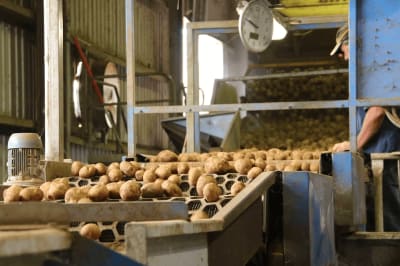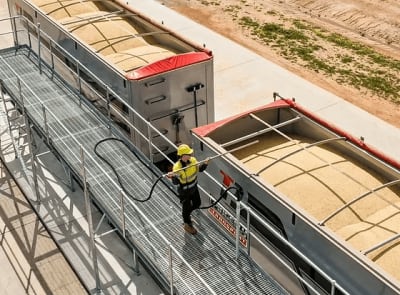SwarmFarm

Our journey started back in 2012 when we decided that enough was enough, farming couldn’t continue with ever larger and more complicated machines. We had a clear vision to create better farming systems and unlock the promise of autonomous agriculture.
This case study was originally published in our report,
Funding the Future: Strategies to secure funding for Australian agribusinesses | Download the full report >>
It would be hard to find a new agricultural or agtech business more revolutionary, more innovative and initially more risky and difficult to comprehend – and so difficult to attract funding for – than Andrew and Jocie Bate’s SwarmFarm robot company.
In the beginning, back in 2012, it was just the couple operating from the verandah of their grain property near Emerald in central Queensland, fuelled by a great idea, fiddling with little bits of machinery and desperately trying to attract the interest of universities and government grant agencies.
Now, 12 years later, SwarmFarm has more than 86 of its small robots operating commercially on farms, vineyards, orchards and turf farms around Australia, doing everything from precision spraying weeds in grain crops to mowing turf 24/7.
It is one of only a handful of companies worldwide making and selling agricultural robots successfully, with huge interest now coming from the United States in its robot technology. Its robots have accumulated more than 150,000 engine hours of commercial agricultural work, outside of early trials and R&D.
SwarmFarm’s point of difference is that its autonomous robots are small, light and built to zip around paddocks without supervision and in groups or a “swarm” if required – all controlled by a mobile phone app – rather than massive, expensive and heavy existing tractors converted to operatorless-driving, as has been the main US pathway led by companies such as John Deere.
“It’s been a hard journey but I think we are starting to get there,” says Andrew Bate. “The hardest part has been trying to change people’s thinking; to help them understand that this is not just about labour savings, much lower chemical-use or replacing their big tractor, or even about automated farming.
“Yes, it’s all of those things, but my wider purpose has always been to re-imagine and reinvent how we can farm better and to help create new farming systems of the future that take us into the next productivity wave, using robotics to achieve that; it’s the really exciting revolution ahead,” says Bate.
SwarmFarm’s Farmbot base robot – the size of a small car – sells for about $305,000, with further mechanical hardware and tailored smart applications costing another $180,000-$350,000 fitted individually on top of the robot base platform to suit each individual purchaser’s requirements for specific agricultural use.
SwarmFarm now has its own cutting-edge engineering and robot construction factory located on the Bates’ rural farm. More than 25 of Australia’s brightest young tech-heads and robot engineers have moved to Emerald to be involved in the exciting venture. Another 30 employees are located across Australia, with plans to establish a team – and possibly a robot factory – in the US next.
Jocie Bate, SwarmFarm Chief Financial Officer, says almost every type of funding has been accessed in the growth of their robot business, taking it from a penniless agtech start-up to now being a private incorporated company with many shareholder investors and more than $15m of investment funding behind it.
Initially SwarmFarm was assisted in its earliest days by research co-operation with several universities, industry partnerships with companies such as Westpac, Elders and Telstra and grant funding from the federal and Queensland governments. “We call those days the “Valley of Death”; we had our early prototypes and there was enormous interest in what we were doing.





